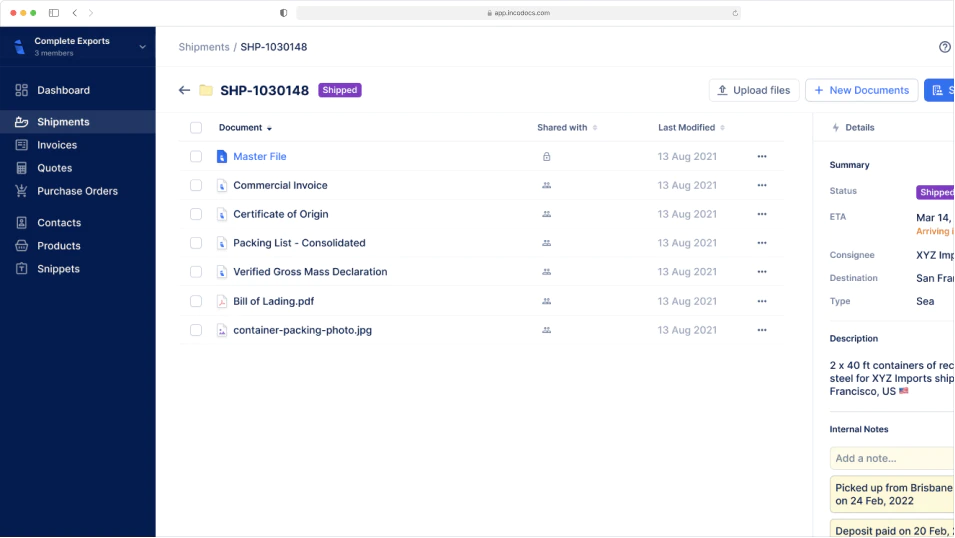IncoDocs raises $1.2M seed round led by Maersk GrowthRead the announcement

Phytosanitary Certificate Template
What is a Phytosanitary Certificate used for?
A phytosanitary certificate is used in export certification to show that plants and plant products meet the importing country’s phytosanitary regulations. Importers may require it for seeds, bulbs, tubers, fruits, vegetables, cut flowers, branches, grain, and growing media. Some processed plant products such as cotton or wood may also need certification if they pose a risk of spreading pests. In some cases, certificates are required for regulated articles like empty shipping containers, vehicles, or other materials that could carry contamination. Without a valid certificate, shipments may be refused at customs and can be detained or destroyed.
How to create a Phytosanitary Certificate
Open IncoDocs
Open IncoDocs in your browser and navigate to the “Export Docs” section.
Choose the Phytosanitary Certificate template
Click on 'New document set' and select the Phytosanitary Certificate template along with any other export documents you wish to create.
Fill out & customize your doc
Fill out the document, customize template fields to your needs and add your company letterhead. To save time and prevent re-entry errors, enter key shipment data into the Master File to have it sync across all other documents in your set automatically.
Sign & seal
Click on the signature box at the bottom of your document to create and place a digital signature then hit “Save & Quit”. On the document preview screen, click on the ‘More’ dropdown button and select “Add company seal” to place a digital stamp.
Download or share
Download or share documents from IncoDocs in 1-click. Documents can be downloaded as PDF or CSV which can be imported into other systems without manual re-entry.
Your questions, answered.
How to obtain a Phytosanitary Certificate for export shipments?
The importer of goods requires a phytosanitary certificate to get the products cleared through customs before the shipments arrives into port. The shipper of the goods must contact their country’s relevant department for inspection and apply for the phytosanitary certification. Usually applicants must first be registered with the department before applying for the relevant certificate. The exporter’s facility may have to undergo an inspection by an authorized officer to ensure compliance with strict hygiene standards and federal regulations for export.
Today most government departments require shippers to apply for Health certificates and phyto certificates online. However, in some cases a manual paper document can be submitted for approval.
What information is included on a Phytosanitary Certificate Document?
A Phytosanitary Certificate will include the following details to meet federal and foreign requirements:
Who issues the most phytosanitary certificates worldwide?
Phytosanitary certificates are issued by National Plant Protection Organizations (NPPOs). Countries that export large amounts of agricultural goods, such as the U.S., China, and members of the European Union, issue the most. In the U.S., APHIS manages issuance through the Plant Protection and Quarantine (PPQ) export program.
What agency provides phytosanitary certification for agricultural commodities?
In the U.S., this is done by APHIS under its export program. Authorized Certification Officials (ACOs) carry out inspections and issue phytosanitary certificates. Other foreign countries have NPPOs that handle the same process for plants and plant products.
Does the U.S. require a phytosanitary certificate for imports?
Yes. Many agricultural and plant products need a phytosanitary certificate to enter the U.S. This shows that regulated articles meet specified phytosanitary import requirements. Certificates also follow international agreements like the International Plant Protection Convention (IPPC).
Who can issue a phytosanitary certificate?
Only an Authorized Certification Official (ACO) from a recognized NPPO can issue one. These officials are technically qualified and duly authorized under ISPM standards. Most use the Phytosanitary Certificate Issuance and Tracking System (PCIT) to complete issuance.
What is a phytosanitary certificate for re-export?
This is used when foreign-origin agricultural commodities are brought into one country and then shipped to another. The NPPO issues a new certificate to attest that the articles meet specified phytosanitary import requirements. It may be based on the original certificate, an additional inspection, or both.
Do I need a Phytosanitary Certificate for each plant?
You do not need a separate phytosanitary certificate for each plant. One certificate covers an entire shipment of plants or plant products. The certificate issuance verifies that all items in the shipment meet the importing country’s phytosanitary requirements.
Do seeds require a Phytosanitary Certificate?
Yes, seeds generally require a phytosanitary certificate. The certificate ensures that the seeds are free from pests and diseases and meet the importing country's health standards. This is important to prevent the introduction of harmful organisms.
Do Phytosanitary Certificates expire?
Yes, phytosanitary certificates do expire. They are only valid for the specific shipment for which they were issued. After the shipment is completed, the certificate cannot be reused, and the exporter must obtain a new issuance for future shipments.
Free to start,
Easy to use.
Setup in 5 mins.
